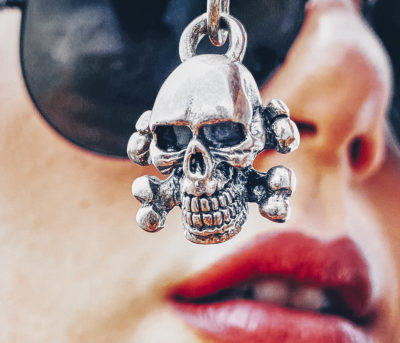
The skull is one of the most ancient symbols that survived to the present day. It didn’t lose its relevance in the new millennia, it is thriving now. The reason behind its revival is that many popular and not so popular (sub)cultures chose skulls as their identification mark. Bikers, punks, Goths, metalheads, as well as pirates, the military, and sorcerers made the skull part of their image. Before we knew it, skulls entered our lives.
You won’t scare anyone by wearing T-shirts with skull prints or skull necklaces. But are skulls fashionable just because they are outrageous and the desire to shock is in our blood? Well, not exactly. The skulls are appealing because they are ambiguous. They have many layers of meanings, just like an onion. But once you get to the next layer, it won’t make you cry. Rather, it will make you admire. Do you know all the meanings of the skull?
Hermit Symbol
In Catholic Christianity, the skull is not only a symbol of death but also a symbol of humility. It was mandatory for hermits to wear. The skull meant that a hermit resigned himself, prepared himself for death, whenever it occurs, and he has no contempt for earthly things, including his own body. Renunciation of everything that connects a person with this world was one of the conditions for the salvation of the soul.
There were many superstitions associated with hermits and their gloomy attire in medieval Europe. In particular, it was believed that hermits coming to towns and villages were harbingers of epidemics and wars. Just one look at a hermit made villagers flee in horror.
Salvation from Sin
According to the Christian tradition, the skull is called Adam’s head. It became a symbol of resurrection, spirituality, and immortality of the soul. The legends say that the ashes of Adam are buried on the Golgotha Mountain, the place where Christ was crucified. The blood of Christ washed Adam’s skull and thus cleaned humanity from the filth of sin giving it a chance for salvation. Adam’s head has a symbolic meaning of deliverance from death and salvation in the Christian sense. The image of the skull often becomes part of crucifixes and clothes of Orthodox monks.
Death Warning
For Catholic Christians, death isn’t something extraordinary. They know that death is the most ancient biological function, just like birth. Nature developed the mechanisms of dying with the same attention as the mechanisms of birth, with care for the welfare of the body, with the same abundance of genetic information. Before coming, death places its signs and carefully warns of its approach. The most powerful of these harbingers are bones and skulls. Even the tradition of wearing memento mori rings was based on the skull image.
Predictions of the Future
The skull is an irreplaceable attribute of sorcerers, shamans, witches, and everyone who is endowed with the gift of extrasensory perception. It is believed that the skull is a sort of conductor between our world and the kingdom of spirits. Various magical rituals use skulls to ensure protection against evil spirits and maintain contact with deceased ancestors. Fortune-tellers believe that the skull can tell about the future and the past and predict the fate of a person. They put it at the head of a bed and ordered it to tell the truth about what happened and what will happen.
Guard and Patron
The Vikings believed that enemies wouldn’t resurrect if they cut their heads off. In the Middle Ages, revenge wasn’t complete unless the skull of an enemy was impaled over the walls of a fortress. These skulls, doomed to torment and rage, and looking at the prosperous life of their victor, frightened everyone who intended to take a fortress by storm. Thus, they guarded everyone who lived within the fortress walls.
The skulls of deceased relatives and prominent tribesmen also became protectors. They were treated with reverence. People built altars for them and gave them due honors. Our ancestors believed that if they buttered up the spirits of the dead, they would help them in this mortal world.
The Symbol of Intelligence
Medieval philosophers perceived the skulls as a receptacle of wisdom. When it was found that the skull houses the brain, it was studied by numerous medical and philosophical treatises dedicated to the topic of mind, body, and soul. Medieval thinkers did not separate the concept of the mind from the skull; rather, they connected them together. The mind is something ephemeral but thanks to the skull, this concept acquired a tangible physical form.
Danger Symbol
Many of us know the symbol of the skull and crossbones as the pirate flag, Jolly Roger. Historians believe that this name comes from the French ‘Joyeux Rouge’ (bright red). Pirates raised a black flag to issue an ultimatum. If a ship crew did not surrender, corsairs flew a red flag. Later, the British remade Rouge into Roger and Joyeux into Jolly.
Although pirates no longer plow peaceful waters, the skull and crossbones still carry the meaning of danger. You can see this symbol on bottles of poisonous fluids and signs warning of high voltage.
So, how many of these meanings did you know?


